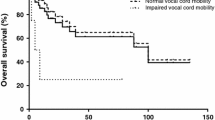Abstract
In the present study, we look at the prognostic implications of the recovery of vocal cord mobility after treatment in T3 laryngeal and hypopharyngeal cancers with fixed vocal cords. Patients with T3 laryngeal and hypopharyngeal carcinoma were considered for the study. All patients were treated with standard laryngeal preservation protocols as per treatment guidelines. Recovery of vocal cord functions was assessed with serial flexible laryngoscopic evaluation. Recovery of vocal cord mobility was compared with oncological outcomes. Twenty seven patients were available for final analysis. Cases, where vocal cords remained fixed or continued to have restricted mobility on follow up, were categorised as “unfavourable” and those with complete recovery of function as compared to pre treatment FOL as “Favourable”. Thirteen (48%) patients did not regain complete mobility of vocal cords. Six patients from the ‘unfavourable’ group (46%) developed recurrence, whereas only one patient from the ‘favourable’ group (7%) had a recurrence (p = 0.03). The findings of the present study suggest that failure to regain complete vocal cord mobility after CTRT is a poor prognostic factor in T3 laryngeal and hypopharyngeal cancers.
Similar content being viewed by others
References
Bobdey S, Jain A, Balasubramanium G (2015) Epidemiological review of laryngeal cancer: an Indian perspective. Indian J Med Paediatr Oncol 36(3):154
Groome PA, O’Sullivan B, Irish JC, Rothwell DM, Schulze K, Warde PR, Schneider KM, Mackenzie RG, Hodson DI, Hammond JA, Gulavita SP (2003) Management and outcome differences in supraglottic cancer between Ontario, Canada, and the Surveillance, Epidemiology, and End Results areas of the United States. J Clin Oncol 21(3):496–505
Department of Veterans Affairs Laryngeal Cancer Study Group* (1991) Induction chemotherapy plus radiation compared with surgery plus radiation in patients with advanced laryngeal cancer. N Engl J Med 324(24):1685–1690
Forastiere AA, Goepfert H, Maor M, Pajak TF, Weber R, Morrison W, Glisson B, Trotti A, Ridge JA, Chao C, Peters G (2003) Concurrent chemotherapy and radiotherapy for organ preservation in advanced laryngeal cancer. N Engl J Med 349(22):2091–2098
Adelstein DJ, Lavertu P, Saxton JP, Secic M, Wood BG, Wanamaker JR, Eliachar I, Strome M, Larto MA (2000) Mature results of a phase III randomized trial comparing concurrent chemoradiotherapy with radiation therapy alone in patients with stage III and IV squamous cell carcinoma of the head and neck. Cancer 88(4):876–883
Lefebvre JL, Andry G, Chevalier D, Luboinski B, Collette L, Traissac L, De Raucourt D, Langendijk JA, EORTC Head and Neck Cancer Group (2012) Laryngeal preservation with induction chemotherapy for hypopharyngeal squamous cell carcinoma: 10-year results of EORTC trial 24891. Ann Oncol 23(10):2708–2714
Machtay M, Moughan J, Trotti A, Garden AS, Weber RS, Cooper JS, Forastiere A, Ang KK (2008) Factors associated with severe late toxicity after concurrent chemoradiation for locally advanced head and neck cancer: an RTOG analysis. J Clin Oncol 26(21):3582
Forastiere AA, Zhang Q, Weber RS, Maor MH, Goepfert H, Pajak TF, Morrison W, Glisson B, Trotti A, Ridge JA, Thorstad W (2013) Long-term results of RTOG 91–11: a comparison of three nonsurgical treatment strategies to preserve the larynx in patients with locally advanced larynx cancer. J Clin Oncol 31(7):845
Hutcheson KA, Alvarez CP, Barringer DA, Kupferman ME, Lapine PR, Lewin JS (2012) Outcomes of elective total laryngectomy for laryngopharyngeal dysfunction in disease-free head and neck cancer survivors. Otolaryngol-Head Neck Surg 146(4):585–590
Katιlmιş H, Öztürkcan S, Özdemir İ, Adadan I, Tunç A, Akder A, Başoğlu S (2007) A clinico-pathological study of laryngeal and hypopharyngeal carcinoma: Correlation of cord-arytenoid mobility with histopathologic involvement. Otolaryngol-Head Neck Surg 136(2):291–295. https://doi.org/10.1016/j.otohns.2006.08.022
Liu W, Fei S, Li S (1997) On the mechanism of hemilaryngeal fixation in pyriform sinus carcinoma and its clinical significance. Zhonghua Er Bi Yan Hou Ke Za Zhi 32(3):135–138
Iloabachie K, Nathan CA, Ampil F, Morgan ML, Caldito G (2007) Return of vocal cord movement: an independent predictor of response to nonsurgical management of laryngeal cancers. Laryngoscope 117(11):1925–1929
Solares CA, Wood B, Rodriguez CP, Lorenz RR, Scharpf J, Saxton J, Rybicki LA, Strome M, Esclamado R, Lavertu P, Adelstein DJ (2009) Does vocal cord fixation preclude nonsurgical management of laryngeal cancer? Laryngoscope 119(6):1130–1134
McCoul ED, Har-El G (2009) Meta-analysis of impaired vocal cord mobility as a prognostic factor in T2 glottic carcinoma. Arch Otolaryngol Head Neck Surg 135(5):479–486. https://doi.org/10.1001/archoto.2009.47
Lefebvre JL, Ang KK, Larynx Preservation Consensus Panel (2009) Larynx preservation clinical trial design: key issues and recommendations—a consensus panel summary. Head Neck 31(4):429–441
Author information
Authors and Affiliations
Corresponding author
Ethics declarations
Conflict of Interest
The author declare that they have no conflict of interest.
Ethical Approval
IRB Ethical clearance has been obtained for the study.
Additional information
Publisher's Note
Springer Nature remains neutral with regard to jurisdictional claims in published maps and institutional affiliations.
Rights and permissions
About this article
Cite this article
Rao, V.U.S., Majumdar, K.S., Subash, A. et al. Prognostic Significance of Vocal Cord Mobility after Laryngeal Preservation Protocols in Locally Advanced Laryngopharyngeal Cancers: A Retrospective Analysis. Indian J Otolaryngol Head Neck Surg 73, 207–211 (2021). https://doi.org/10.1007/s12070-020-02306-w
Received:
Accepted:
Published:
Issue Date:
DOI: https://doi.org/10.1007/s12070-020-02306-w




